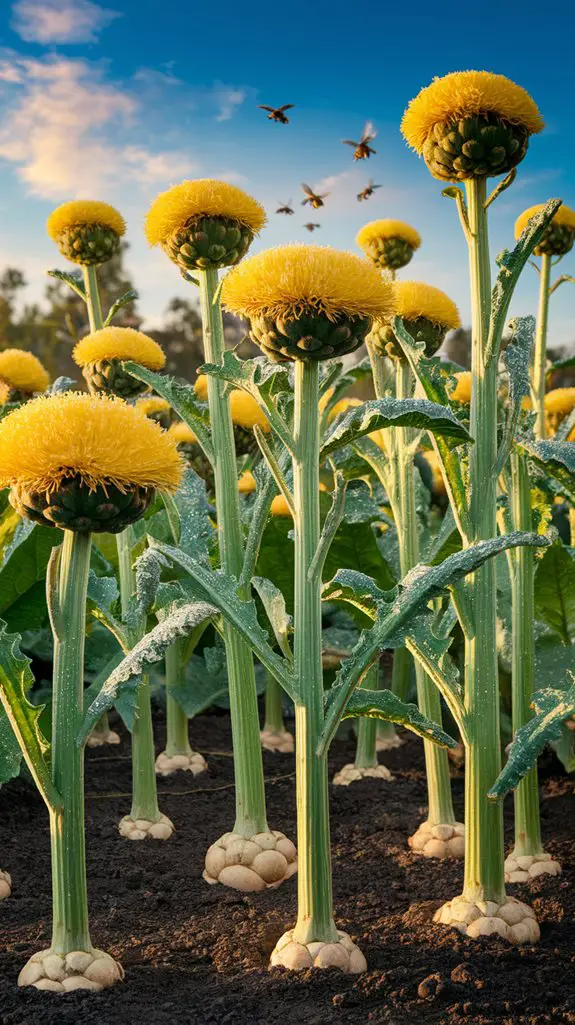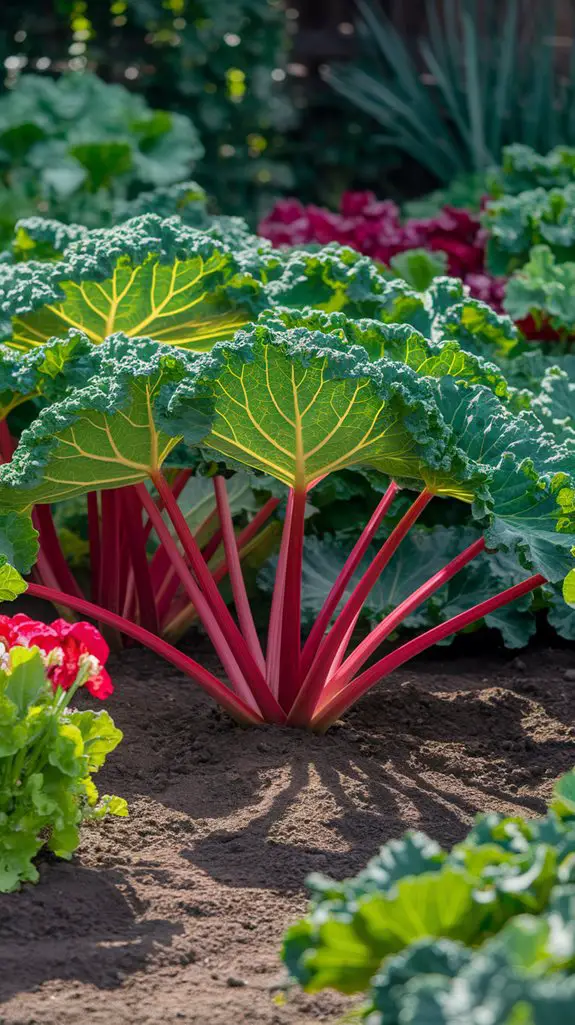You’ve likely grown annual vegetables and experienced the cycle of planting, harvesting, and starting over each year. But what if you could plant once and harvest for years? Perennial vegetables offer this advantage, creating a productive garden that requires less work over time. These resilient plants establish deep root systems, improve your soil structure, and provide reliable harvests despite challenging weather conditions. Ready to transform your backyard into a self-sustaining food system that grows stronger each season?
Asparagus: The Long-Term Green Investment
Patience is the virtue that defines asparagus cultivation. When you establish an asparagus bed, you’re making a 15-20 year commitment that doesn’t yield harvests until the third season.
Plant one-year-old crowns in early spring, burying them in trenches 6-8 inches deep with 18 inches between plants.
The perennial’s productivity improves annually, eventually yielding up to 2 pounds per plant. You’ll recognize harvest-ready spears when they reach 8-10 inches tall with tightly closed tips.
Cease harvesting when newer spears emerge thinner than a pencil—this preserves energy for next year’s crop.
Asparagus thrives in full sun and well-drained soil with pH 6.5-7.5. Its deep root system makes it drought-tolerant once established, though consistent moisture during establishment enhances long-term vigor.
Jerusalem Artichokes: Easy Harvests Year After Year

While asparagus demands years of patience before yielding its first harvest, Jerusalem artichokes (Helianthus tuberosus) offer almost immediate gratification with minimal effort. These native North American tubers produce abundantly with virtually no care once established, providing nutritional bounty through winter. Additionally, growing them in raised garden beds can enhance drainage and make harvesting easier.
| Characteristic | Details |
|---|---|
| Planting Time | Early spring or fall |
| Sunlight Needs | Full to partial sun |
| Harvest Period | Late fall after frost to early spring |
| Storage | Leave in ground or refrigerate tubers |
| Culinary Uses | Raw, roasted, mashed, soups |
You’ll find these plants reach 6-10 feet tall, producing cheerful yellow sunflower-like blooms in late summer. The tubers contain inulin rather than starch—beneficial for diabetics but potentially causing flatulence in sensitive individuals. Plant where they can spread without becoming invasive, as they’ll return reliably for years.
Rhubarb: The Colorful Perennial That Keeps Giving

For gardeners seeking vibrant color and culinary versatility, rhubarb (Rheum rhabarbarum) stands as one of the most rewarding perennial vegetables you can grow. Its crimson stalks emerge reliably each spring, offering harvests for up to 20 years from a single planting.
You’ll find rhubarb thrives in USDA zones 3-8, preferring rich, well-drained soil with consistent moisture. Plant crowns in early spring, positioning them 3-4 inches below soil level with eyes facing upward.
Allow plants to establish fully before harvesting—typically waiting until the second or third year.
When harvesting, pull stalks gently from the base rather than cutting them. Remember that only the stalks are edible; the leaves contain high levels of oxalic acid and are toxic to humans.
Walking Onions: Self-Propagating Alliums for Every Garden
Walking onions (*Allium × proliferum*), also known as Egyptian or tree onions, represent one of the most fascinating and low-maintenance additions to a perennial vegetable garden.
These curious alliums earn their name from the way they “walk” across your garden by producing topsets (bulbils) that develop at the tips of their stalks. When these aerial bulblets become heavy, they bend to the ground and root, creating new plants.
You’ll find their flavor similar to shallots but with a sharper bite. Every part is edible—from underground bulbs to green stalks and topsets.
Plant them in well-drained soil with full sun to part shade, spacing them 6-8 inches apart. They’ll thrive for years with minimal care, resisting most pests and diseases that trouble other onion varieties.
Perennial Kale and Collards: Leafy Greens That Endure
Moving from the self-propagating alliums, we encounter another category of perennials that offers remarkable sustainability in the home garden.
Perennial kale and collards (Brassica oleracea) varieties like ‘Daubenton’ and ‘Tree Collards’ can produce nutritious leaves for 3-5 years from a single planting.
You’ll find these brassicas contain higher concentrations of antioxidants than their annual counterparts due to their established root systems.
Plant them in partially shaded locations with well-draining soil amended with compost. Unlike annual kales, they won’t bolt during summer heat, providing continuous harvests throughout multiple seasons.
Regular pruning encourages bushy growth and prevents woodiness.
Propagate easily through stem cuttings placed in water until roots develop.
These resilient plants resist many common garden pests while serving as productive alternatives to seasonal replanting.
Conclusion
Your perennial vegetable garden functions like a living retirement account, growing in value and yield with each passing season. You’ll reap dividends of flavor while minimizing the annual labor investment typically required for traditional vegetable plots. By incorporating these resilient plants into your landscape, you’re establishing a self-sustaining food system that aligns with ecological principles and guarantees your kitchen remains stocked with nutritious homegrown options for years to come.




